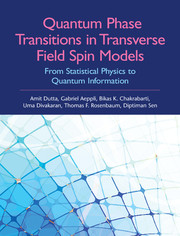 Quantum Phase Transitions in Transverse Field Spin Models
Quantum Phase Transitions in Transverse Field Spin Models Book contents
- Frontmatter
- Dedication
- Contents
- List of Figures and Tables
- Preface
- Acknowledgements
- I An Introduction to Quantum Phase Transitions, Information and Dynamics
- II Transverse Field Models: Statics
- III Transverse Field and Related Models: Non-Equilibrium Dynamics
- IV Experimental Realizations of Transverse Field Models
- 14 Experimental Realizations of Transverse Field Ising Systems
- V Quantum Annealing and Adiabatic Quantum Computations Using Transverse Field Models
- Appendix A Derivation of a Matrix Product Hamiltonian
- Appendix B From Jordan–Wigner to Bosonization: Tomonaga–Luttinger Liquids
- Appendix C Calculation of the Entanglement Entropy for a Transverse Ising Chain
- Appendix D The Loschmidt Echo for the One-Dimensional XY Model
- Appendix E Landau–Zener Tunneling: Calculation of Non-Adiabatic Transition Probability
- Appendix F A Note on the Theoretical Studies of Hysteresis
- References
- Index
- Plate Section
14 - Experimental Realizations of Transverse Field Ising Systems
from IV - Experimental Realizations of Transverse Field Models
Published online by Cambridge University Press: 05 May 2015
- Frontmatter
- Dedication
- Contents
- List of Figures and Tables
- Preface
- Acknowledgements
- I An Introduction to Quantum Phase Transitions, Information and Dynamics
- II Transverse Field Models: Statics
- III Transverse Field and Related Models: Non-Equilibrium Dynamics
- IV Experimental Realizations of Transverse Field Models
- 14 Experimental Realizations of Transverse Field Ising Systems
- V Quantum Annealing and Adiabatic Quantum Computations Using Transverse Field Models
- Appendix A Derivation of a Matrix Product Hamiltonian
- Appendix B From Jordan–Wigner to Bosonization: Tomonaga–Luttinger Liquids
- Appendix C Calculation of the Entanglement Entropy for a Transverse Ising Chain
- Appendix D The Loschmidt Echo for the One-Dimensional XY Model
- Appendix E Landau–Zener Tunneling: Calculation of Non-Adiabatic Transition Probability
- Appendix F A Note on the Theoretical Studies of Hysteresis
- References
- Index
- Plate Section
Summary
The Ising model in transverse magnetic field is perhaps the simplest quantum spin model, yet the elements of site disorder, random magnetic fields, and tunable quantum fluctuations permit a rich array of ground states, and the rare ability to emphasize their classical or quantum character. We briefly review in this chapter experimental results from chains to crystals of spins, with magnetic, glassy, and spin liquid ground states.
Singlet Ground State Magnets
In a crystalline lattice, the crystal fields often take a form such that the ground states of magnetic ions are singlets separated from the higher lying spin multiplets. Sufficiently strong magnetic dipolar or exchange couplings between different sites can mix the singlets with the multiplets enough so as to induce non-zero expectation values for the magnetic dipoles at individual sites. Examples of this phenomenon are generally found among metals and insulators based on rare earths. Such metals were a subject of extensive research in the 1960's and 1970's, and the book by MacKintosh and Jensen [408] gives an excellent account of both the data as well as mean field approaches. With respect to insulating materials, LiTbF4 emerged as a model system in the 1970's. It is an example of an ideal Ising dipolar coupled ferromagnet; here the long-range nature of the dipolar interactions leads to an upper critical dimension [149] (at which mean field theory with logarithmic corrections calculable using RG methods becomes an exact description of thermal phase transitions) of three rather than four.
LiTbF4 belongs to the LiREF4 isostructural series of ionic salts. Li and F carry valences +1 and −1 respectively, leaving RE, which can be any rare earth atom or the nonmagnetic element Y, with a valence of +3. Figure 14.1 shows the body-centered tetragonal crystal structure for the family.
- Type
- Chapter
- Information
- Quantum Phase Transitions in Transverse Field Spin ModelsFrom Statistical Physics to Quantum Information, pp. 231 - 244Publisher: Cambridge University PressPrint publication year: 2015


